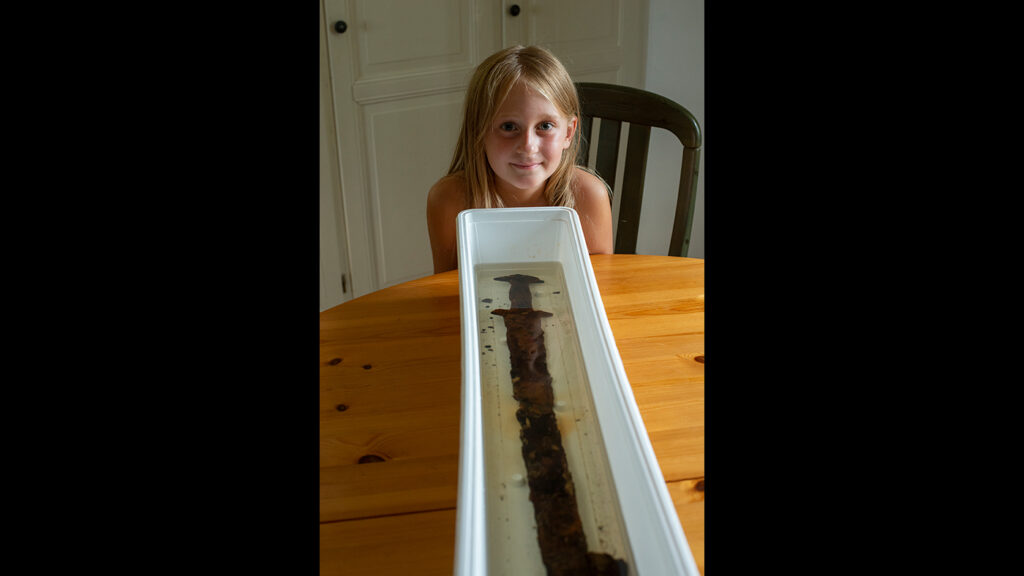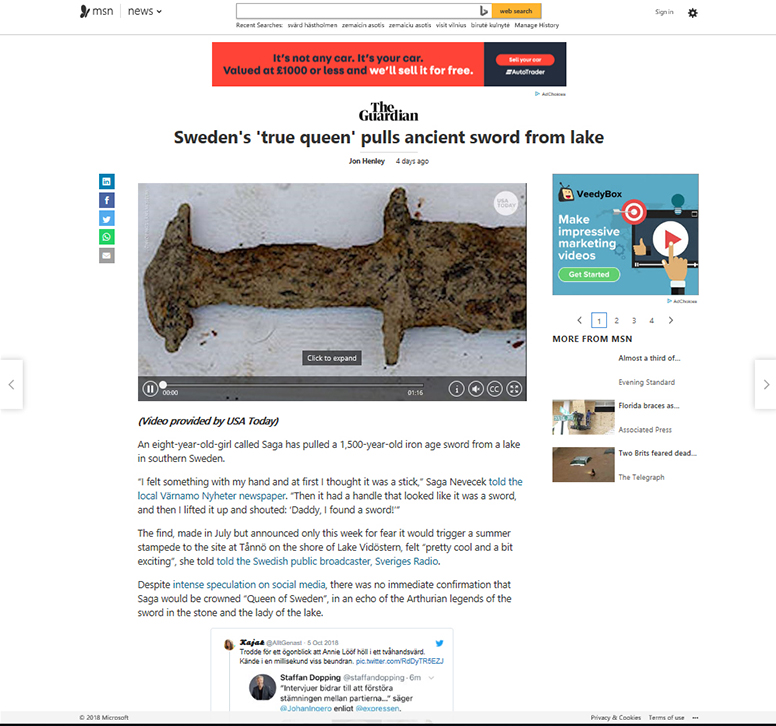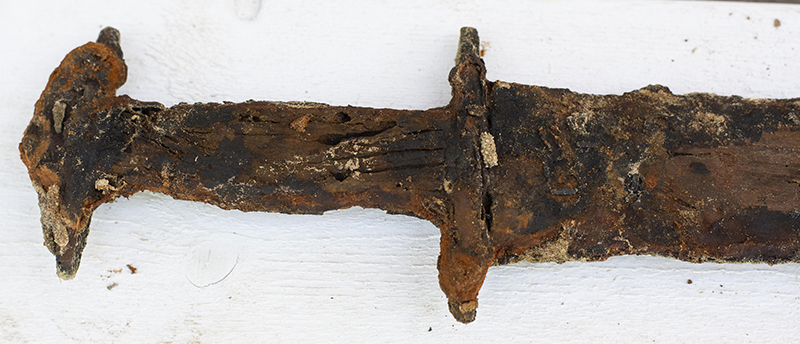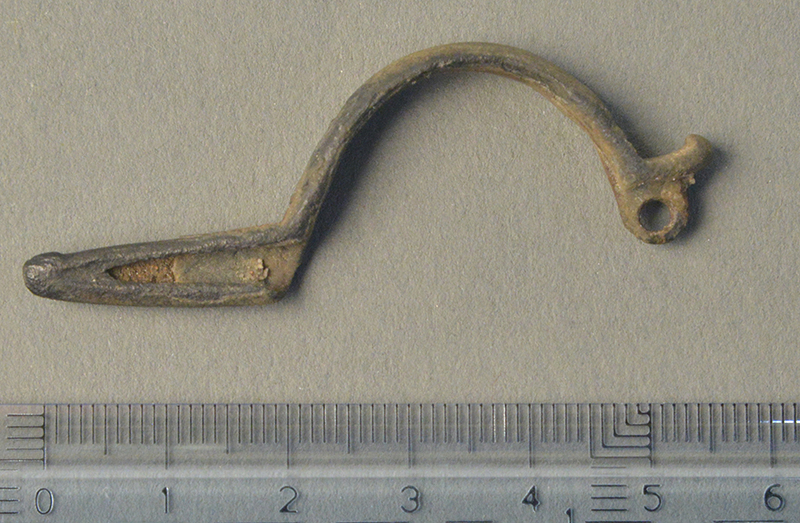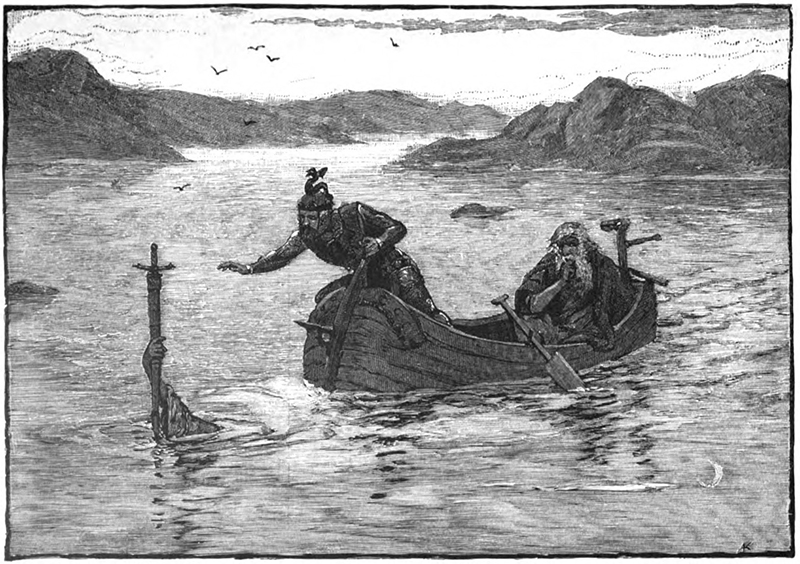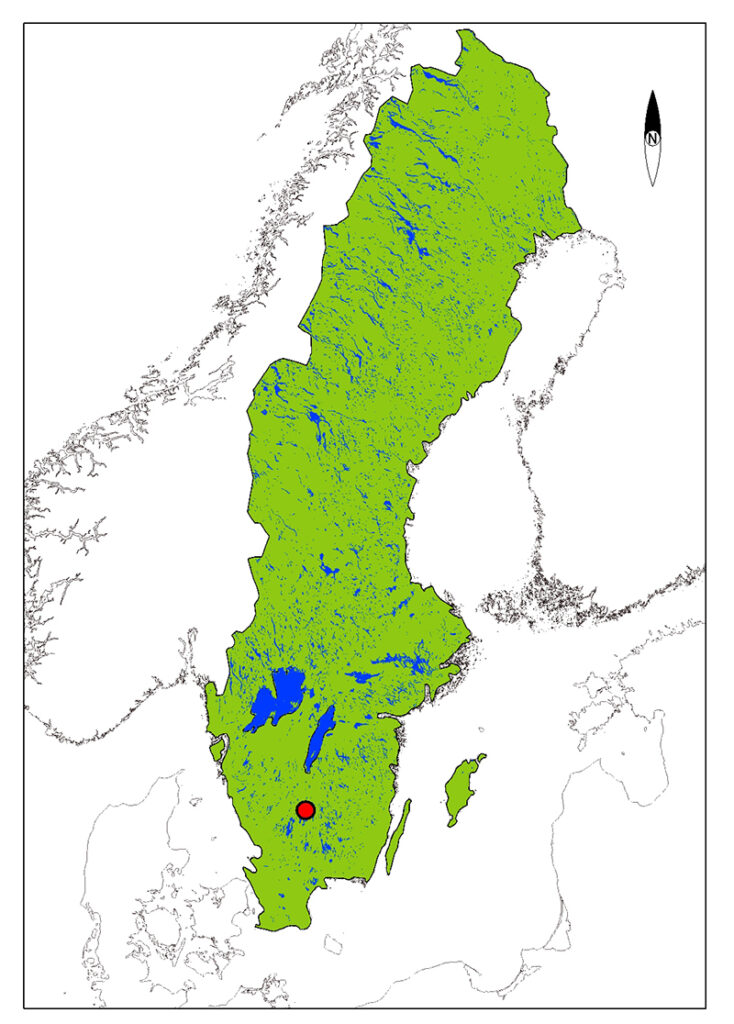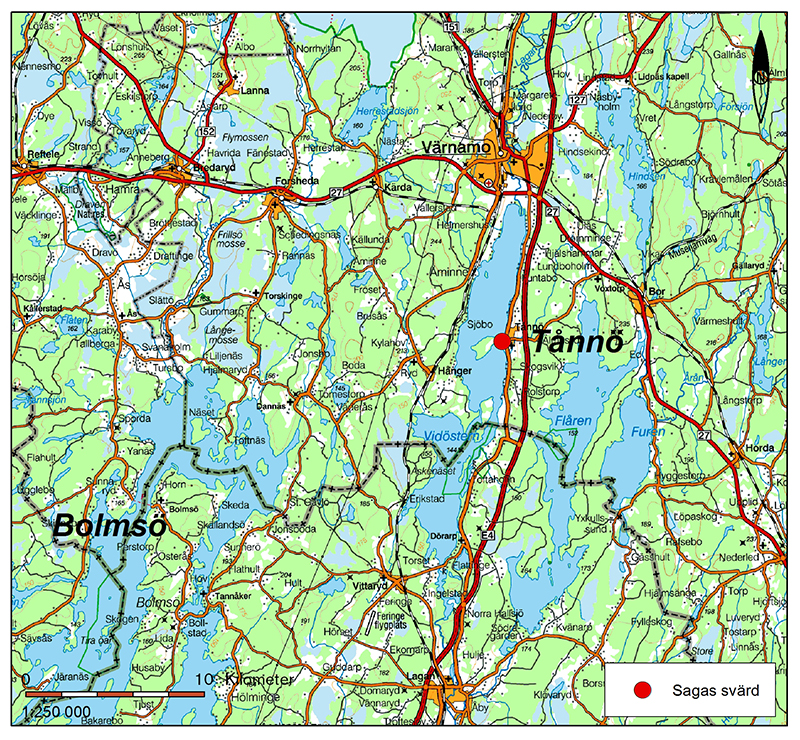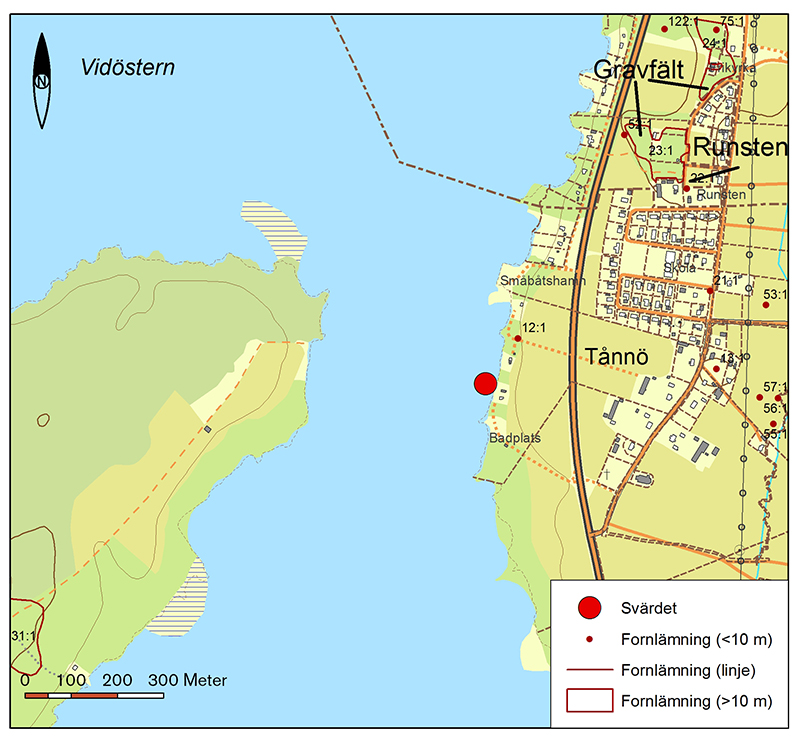Saga’s sword – world news
Publicerat: 16 okt, 2018There’s something special about a sword! Not least when it’s been found by a small girl. We realised that the story would attract attention, but perhaps not exactly how much. The interest was huge, and the world press stood in line to find out more about Saga and her sword. The early days in October 2018 will long be remembered by us and the Vanecek family.
HOW SAGA FOUND THE SWORD
This summer, Saga Vanecek was together with her family at their country house in Tånnö outside Värnamo. It was a hot day, and Saga was in the water looking for stones and sticks in Lake Vidöstern. She was feeling her way along the bottom and came across a long object. She felt something that could be a handle, gripped it and pulled it out of the water. She called to her father: ”Daddy, I’ve found a sword!”. The family soon realised that this was not a sword that had ended up in the water in modern times. They contacted Jönköping County Museum.
SAGA’S SWORD BECOMES WORLD NEWS
In connection with a metal detector search of the discovery site in early October, the local press was invited to meet the archaeologists and especially Saga and her family. There was already at that time a great interest, and local newspapers, radio and television ran stories on the spectacular find.
It took only a couple of hours for the news to spread further, and soon articles appeared in national media: Värnamo Nyheter, Sveriges Radio, Sveriges Television, Expressen och Aftonbladet.
But this was not the end. International press picked up the news, and Saga and the sword in the lake soon became known around the world. Jönköping County Museum, Jönköping County Administrative Board and Saga’s family were interviewed by numerous international media, and the news about the sword is still spreading at the time of Writing: The Local, CNN, The Guardian, BBC och New York Times.
The news also spread quickly via social media, such as Facebook and Twitter. And since the story was published during a period when Sweden is without a government, some people joked that the find makes Saga the new Queen of Sweden, drawing parallels with the Lady of the Lake and the legend of Excalibur. On Twitter you can find tributes and even ”fan art” made in honour of Saga and the sword under the hashtag #QueenSaga.
THE FIND
What sort of sword is it that Saga found this summer in Lake Vidöstern, some ten meters from the shore at a depth of half a metre? The water level of the lake was probably lowered by around one to two metres sometime in the first half of the 19th century. Even today, the depth varies significantly due to water level regulation and natural fluctuations depending on precipitation. It is likely that even during the Iron Age, the site was located somewhere in the lake.
How shall we interpret the find? How did the sword end up in the water, exactly here? Were graves erected near the shore eroded by the water? Could someone have dropped the sword during a boat ride? Or was the sword sacrificed to higher powers for desired prosperity or in gratitude for battles won?
The sword is just over 80 cm long and sits in a wooden scabbard. Fragments of leather are attached to the wood. The sword is covered in lake sediment, but some details give us an indication as to how it looked, which in turn allows us to make a preliminary dating. Here the information currently stops. The sword is in the care of a conservator so that it can be preserved for the future. During the conservation process, we expect progressive information about the details: Are there embellishments and decorations? Does the sword consist of other materials than iron, wood and leather?
Initially, we thought that the sword could be dated to the latter part of the Iron Age, perhaps the Vendel Era or the Viking Age, i.e. around 600-1000 AD. But after studying photographs of the sword, kind colleagues have suggested that it is older than that. The assumption is now that the sword can be dated to around 400 or 500 AD, i.e. what we call the Migration Period. The final determination of age will have to wait until we have been able to study more details on the sword and made a radiocarbon analysis of the wood in the scabbard. The sword is now at Studio Västsvensk Konservering (SVK) for conservation. Perhaps in a year’s time, the conservation will be finished and the sword can be shown to visitors at Jönköping County Museum.
METAL DETECTOR SEARCH
On two occasions, Jönköping County Museum together with Jönköping County Administrative Board and the Swedish Metal Detecting Association carried out further investigations at the site. The area has been surveyed with the aid of metal detectors. Another prehistoric object, a so called fibula, was found, as well as an 18th century coin and a small conical lead object – perhaps a weight. Otherwise, a few nondescript iron objects and miscellaneous present-day gadgets were found in the water.
A fibula is a decorative combination of brooch and pin used for fastening garments on the upper body. The fibula is interesting because it is of a type that can be dated to the Migration Period, like the sword, or possibly a little earlier.
VIDÖSTERN
Vidöstern is a long, narrow lake, with a maximum depth of 38 m. Today, the location is around 144 m above sea level, but a study of old maps shows that the lake was lowered in the 19th century. The river Lagan also runs through the lake. The area where the sword was found is shallow and at least 40 m from the shore.
Lake Vidöstern is also known for its bog iron ore which was used by nearby foundries, e.g. Åminne bruk, up until the 1930s.
TÅNNÖ – AN IRON AGE DISTRICT
What ancient remains are found in the Tånnö area that can provide a background to the sword? As early as in the 17th century, attention was drawn to the rune stone and one of the grave fields in Tånnö (RAÄ-nr Tånnö 22:1 and 23:1): ”Just North of the church, inside the field, along the large road that runs from Wärnemo to Hälsingborg, stands a wide stone, inscribed on both sides along the bottom with runic letters written downwards, a so called rune stone. Nearby is a giant’s grave, long and wide, with a stone setting, but now almost level with the ground, on the Western side is a tall standing stone, and there around a few mounds and hills.” The description is found in a nationwide inventory of ancient monuments carried out in 1667. The grave field RAÄ 23:1 consists of 66 visible ancient monuments, of which 23 mounds, 25 round peat-covered stone settings, 1 triangular stone setting and 7 standing stones. There are also around 15 boulders which may also be part of grave constructions.
The rune stone (Sm 61) and the grave fields are located approximately 600 m north-east of the site where the sword was found. A further few hundred metres to the north-east is the grave field RAÄ Tånnö 24:1, with a total of 7 ancient monuments, of which 21 mounds, 25 stone settings and 1 standing stone.
The grave fields can mainly be dated to the Late Iron Age, around 600-1050 AD. But the standing stones indicate that the time depth can go down to the Early and Middle Iron Ages. According to BA Ennes’ drawing of the grave fields from the 1820s, there was also a stone circle at the grave field RAÄ 23, which could today possibly be represented by the above mentioned standing stones.
The rune stone that still stands along the old road tells that: ”Gudvar had this stone erected after Öde, his son, and Karl after Sten, his son. God help the soul.” Overall, the ancient monuments paint a picture of a typical Late Iron Age settlement that later became a church village. The elements of standing stones and possibly a stone circle suggest that the grave fields may go down to the Migration Period and the Roman Iron Age, i.e. 0-550 AD.
Scattered around the parish are a handful of isolated or small groups of graves – round and square stone settings, a trident and a stone circle, probably from the Early or Middle Iron Ages. There are also a few registered settlements and around 20 archaeological sites from the Stone Age. The Bronze Age does not appear as clearly in the picture, but it is most likely there, albeit hidden.
MYTHOLOGICAL SWORDS
The sword is perhaps the main attribute of the warrior. In many old tales and myths, a sword has the main role. Quite often the sword even has a name – for example, Sigurd Favnesbane’s Gram forged by the dwarf Regin or Egil Skallagrimsson’s Dragvendel.
Many comments on Saga’s sword in the last few days have referred to Excalibur and King Arthur. In one version of the legend, Arthur receives the sword from the Lady in the Lake. A suitable reference here.
An Icelandic saga tells the story of the sword Tyrfing. It is called the Hervarar Saga and was recorded in the 14th century. It is of particular interest in this context as part of the tale is believed to have taken part in Småland – on the island of Bolmsö! The saga, which is preserved in several versions, was translated into Swedish by Olof Verelius and was first published in 1672. He identified Bolm in the saga with Bolmsö, even if other locations have later been suggested. The main thread of the story is made up of the sword Tyrfing which was forged by two dwarfs, Dyren and Dvalen, for King Svafurlami. The sword later falls into the hands of Angantyr, who lives on Bolm (probably Bolmsö). Angantyr, together with his eleven brothers, known as the Berserkers, fought Hjalmar and his men in a holmgang (duel) on Samsö. The battle ended when everyone died and were buried together with their arms, in mounds on the island. Angantyr’s wife Svava, daughter of Jarl Bjarmar, later gave birth to their daughter Hervor. It is said of her childhood that she was as strong as a man and preferred practising with a bow, shield and sword to sewing and embroidery. When she found out who her father was she went to Samsö and her father’s grave. She talked to his ghost and requested that he let her have the famous sword. Angantyr warned her against the curse that had been cast over Tyrfing and which threatened to destroy the entire family. Hervor did not give in and Angantyr reluctantly let her have the sword. After a few years of Viking voyages, she returned to her farm and settled down.
A BRIEF OUTLOOK
In 2000, a sword was found during a diving expedition in Lake Vättern outside Hästholmen. The sword, which is around 80 cm long, has a preserved scabbard with several layers of textile and leather. A radiocarbon analysis showed that the sword was from the Vendel Era. No further finds were made at the follow-up investigation.
SOME OTHER SWORDS FROM JÖNKÖPING COUNTY
In the county museum’s collections there are a number of swords from the Bronze and Iron Age. Below are three photos of different swords that can be found in the county museum’s collections.
WHAT HAPPENS NEXT?
The conservation will start, and we expect to gradually have more information about the sword. Samples have been taken for radiocarbon dating and analysis of the wood. Perhaps we will be able to exhibit the sword in autumn 2019. We are also going to evaluate the recent follow-up investigations together with the Jönköping County Administrative Board and plan how and whether to carry out further investigations of the discovery site.
Mikael Nordström och Annie Rosén
i Information
Kategorier
Kontaktuppgifter

Mikael Nordström
Enhetschef Kulturmiljö
Skriv ut sida
Bilder
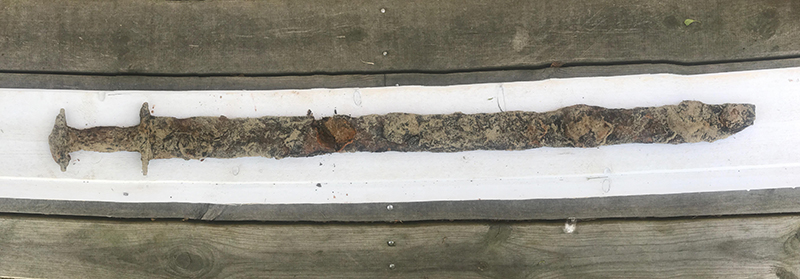 Photographs of the sword directly after it was found. In addition to iron, there are preserved fragments of wood and leather. Photo: Annie Rosén, Jönköping County Museum.
Photographs of the sword directly after it was found. In addition to iron, there are preserved fragments of wood and leather. Photo: Annie Rosén, Jönköping County Museum.
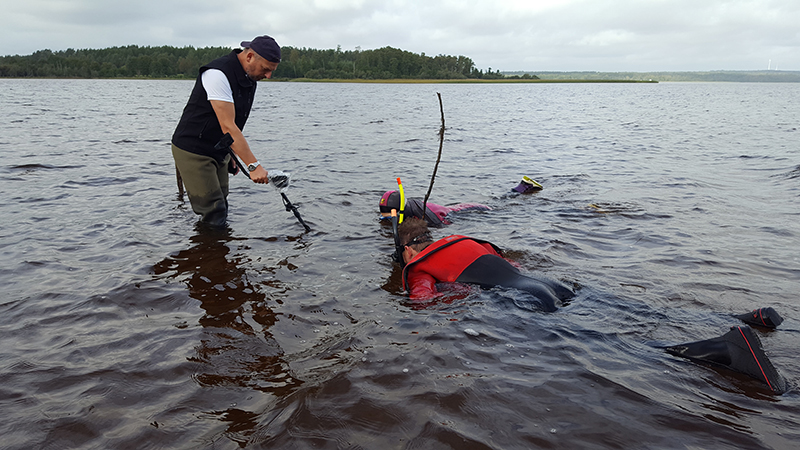 A detector signal is investigated. Anders Kraft operates the detector while Jan Borg and Annie Rosén snorkel around the site. Photo: Anna Kristensson, Jönköping County Administrative Board.
A detector signal is investigated. Anders Kraft operates the detector while Jan Borg and Annie Rosén snorkel around the site. Photo: Anna Kristensson, Jönköping County Administrative Board.
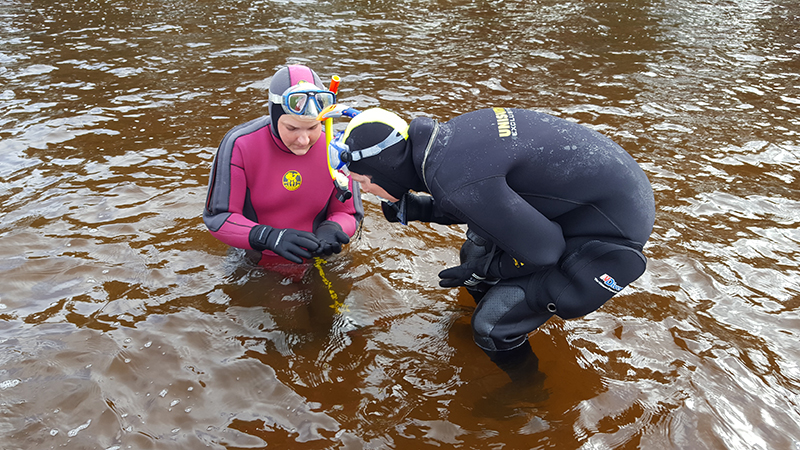 Jackpot - Annie Rosén and Anna Kristensson study a fibula found on the bottom! Photo: Anders Kraft, Jönköping County Administrative Board.
Jackpot - Annie Rosén and Anna Kristensson study a fibula found on the bottom! Photo: Anders Kraft, Jönköping County Administrative Board.
 At the first investigation a fibula was found of a type that has preliminarily been dated to the Late Roman Iron Age or Migration Period (around 200-550 AD). Photo: Mikael Nordström, Jönköping County Museum.
At the first investigation a fibula was found of a type that has preliminarily been dated to the Late Roman Iron Age or Migration Period (around 200-550 AD). Photo: Mikael Nordström, Jönköping County Museum.
 A small conical lead object, possibly a weight? The dating is uncertain, but it could be prehistoric. Tips are gratefully received. Photo: Mikael Nordström, Jönköping County Museum.
A small conical lead object, possibly a weight? The dating is uncertain, but it could be prehistoric. Tips are gratefully received. Photo: Mikael Nordström, Jönköping County Museum.
 Investigation with metal detectors under way. In the background you can just see Tånnö church. Photo: Mikael Nordström, Jönköping County Museum.
Investigation with metal detectors under way. In the background you can just see Tånnö church. Photo: Mikael Nordström, Jönköping County Museum.
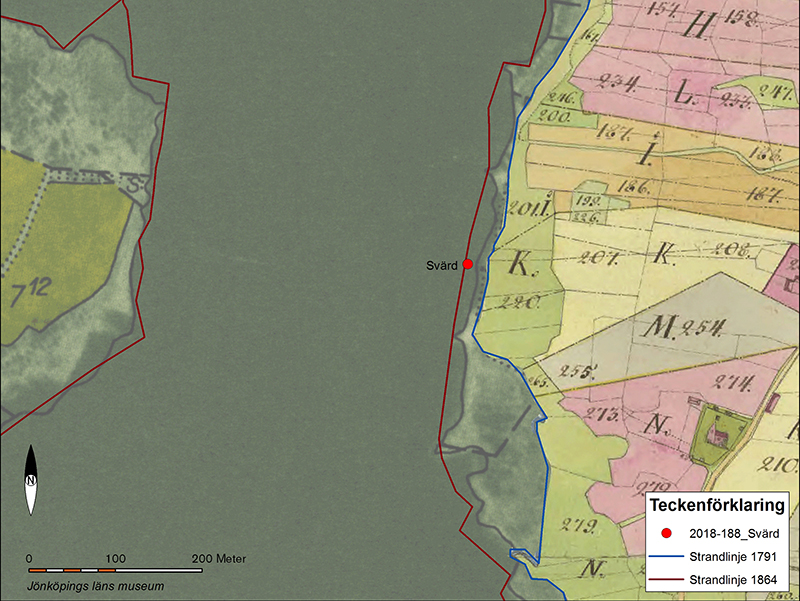 Map showing changes to the shoreline from 1791 to 1950. Lake Vidöstern was probably lowered sometime between 1791 and 1864. Note that the lake has been lowered and raised at different periods. It was at its lowest on the 1864 map, where the sword seems to be located "on land". Note, however, that the area is very flat, and thus a small increase or decrease can make a big difference. It is perfectly clear that that the shoreline varies even today. During 2018 alone, the water level decreased by more than one metre, mainly due to drought and lack of rain.
Map showing changes to the shoreline from 1791 to 1950. Lake Vidöstern was probably lowered sometime between 1791 and 1864. Note that the lake has been lowered and raised at different periods. It was at its lowest on the 1864 map, where the sword seems to be located "on land". Note, however, that the area is very flat, and thus a small increase or decrease can make a big difference. It is perfectly clear that that the shoreline varies even today. During 2018 alone, the water level decreased by more than one metre, mainly due to drought and lack of rain.
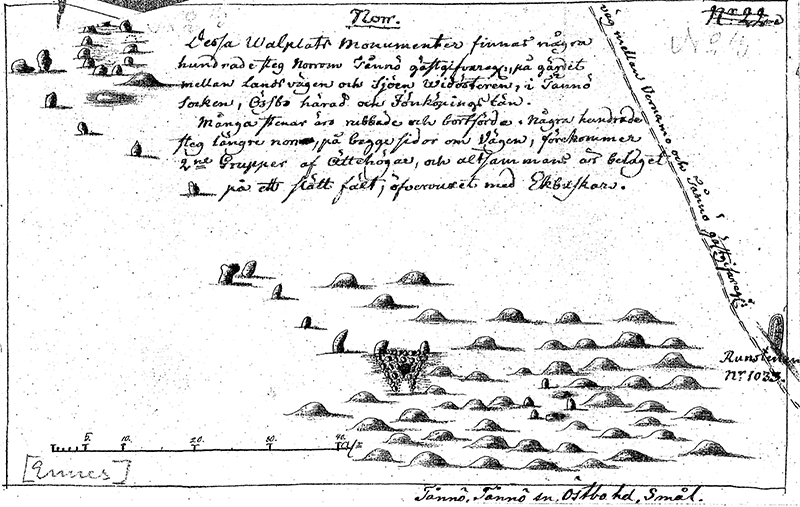 Archaeology researcher BA Ennes' drawing over grave fields and rune stone in Tånnö, from around 1820. ATA.
Archaeology researcher BA Ennes' drawing over grave fields and rune stone in Tånnö, from around 1820. ATA.
 Hervor at her father's burial mound, where she demanded that Angantyr let her have the sword Tyrfing: Christian Gottlieb Kratzenstein-Stub (1783-1816). Public domain.
Hervor at her father's burial mound, where she demanded that Angantyr let her have the sword Tyrfing: Christian Gottlieb Kratzenstein-Stub (1783-1816). Public domain.
 The people of Bolmsö have embraced the Hervarar Saga and have designed a parish banner with a picture of the sword Tyrfing.
The people of Bolmsö have embraced the Hervarar Saga and have designed a parish banner with a picture of the sword Tyrfing.
 One of the two bronze swords found in the bay Huskvarnaviken. The sword, which is 78 cm long, can be dated to the Early Bronze Age, around 1000 BC. One interpretation is that the swords were sacrificed in Lake Vättern to the higher powers. Photo: Mikael Nordström, Jönköping County Museum.
One of the two bronze swords found in the bay Huskvarnaviken. The sword, which is 78 cm long, can be dated to the Early Bronze Age, around 1000 BC. One interpretation is that the swords were sacrificed in Lake Vättern to the higher powers. Photo: Mikael Nordström, Jönköping County Museum.
 In 2008, a grave containing, among other things, a single-edged sword, 48 cm long, and shield was investigated in Odensjö, Barnarp parish, around 10 km south of Jönköping. Surprisingly, the sword had a preserved wooden scabbard (wood normally decays in graves). The wood used for the scabbard was ash. The grave can be dated to the first century AD. See JLM report 2009:06. Photo: Mikael Nordström, Jönköping County Museum.
In 2008, a grave containing, among other things, a single-edged sword, 48 cm long, and shield was investigated in Odensjö, Barnarp parish, around 10 km south of Jönköping. Surprisingly, the sword had a preserved wooden scabbard (wood normally decays in graves). The wood used for the scabbard was ash. The grave can be dated to the first century AD. See JLM report 2009:06. Photo: Mikael Nordström, Jönköping County Museum.
 Sword (74 cm long), shield (boss and handle), two spears, fibula, knife and pin from a grave investigated 1968 in Svenarum. The grave can be dated to the fourth century AD. The fibula resembles the one found in Tånnö, for example the design of the foot and the pin-holder. Photo: Göran Sandstedt, Jönköping County Museum.
Sword (74 cm long), shield (boss and handle), two spears, fibula, knife and pin from a grave investigated 1968 in Svenarum. The grave can be dated to the fourth century AD. The fibula resembles the one found in Tånnö, for example the design of the foot and the pin-holder. Photo: Göran Sandstedt, Jönköping County Museum.

